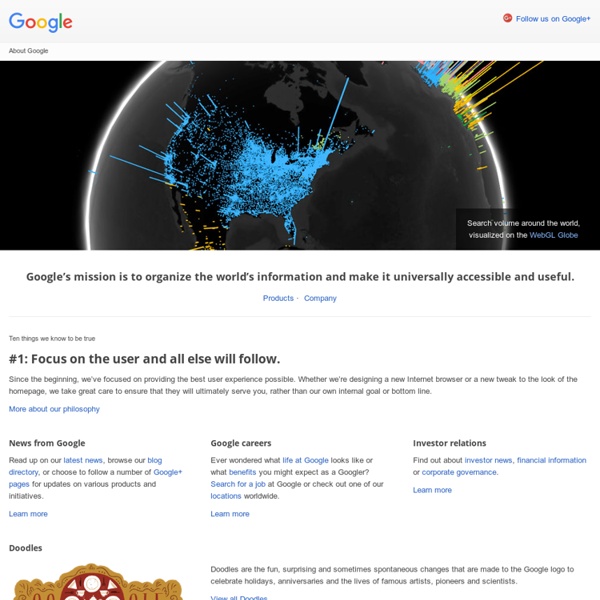



Life at Google Mind meld: Googlers teaching Googlers Collaboration isn’t just about working together to solve problems or overcome challenges. At Google, it’s ... See more Saying "I do" at Google London San Francisco-based Googler Shaun Aukland gained unexpected, international attention when he asked his boyfriend Michael ... See more Google: A great workplace for women At Google, our mission is to organize the world’s information and make it universally accessible. ... See more Global Impact Awards: Giving back at Google scale At Google, we believe in making the world a better place through technology. See more Missions that matter What happens when you mix together entrepreneurial drive, resources, freedom and the urge to do ... See more Employee networks at Google Diversity is a core part of our business and who we are. See more
GOOGLE : UN MYSTÈRE FASCINANT ET BIEN GARDÉ L’infrastructure utilisée par le géant de la recherche Google est un mystère que beaucoup aimeraient percer, que ce soit les concurrents ou les utilisateurs étonnés de la réactivité sans faille des services malgré un nombre d’utilisateurs record. Voici quelques réponses et hypothèses concernant les Data centers de Google. La culture du secret Google estime que leurs Data Centers leur donnent un avantage important face à la concurrence, c’est pourquoi peu d’informations filtrent sur le nombre de centres, leur taille, leur localisation, leur puissance ou encore la consommation électrique de ceux-ci. Pour rester discrets, les data centers ne sont d’ailleurs pas créés sous le nom de Google, mais par des sociétés LLCs (Limited Liability Corporations) soit l’équivalent de nos sociétés à responsabilité limité en France. Où sont les Data Centers ? Voir la carte des Data Centers ici. Le gigantisme Le choix des sites Le choix de l’emplacement des Data Centers est déterminé par plusieurs critères :
Google Linear Book Scanner Linear Book Scanner is a prototype automatic book scanning device. The device moves a book face-down over linear sensors to capture page images, and uses vacuum pressure to turn pages automatically as the book moves. Hardware Follow this design document Software Clone from this git repository Protoypes 2013-12-16 University of Michigan (video) 2013-12-09 Gérard Tolboom 2013-09-11 Dany Qumsiyeh 2012-11-12 Dany Qumsiyeh “This design” means the copyrighted book scanner design distributed by Google as part of the "Linear Book Scanner" project. Google hereby grants to you a perpetual, worldwide, non-exclusive, no-charge, royalty-free, irrevocable (except as stated in this section) patent license to make, have made, use, offer to sell, sell, import, transfer, and otherwise run, modify and propagate this design where such license applies only to those patent claims, both currently owned by Google and acquired in the future, licensable by Google that are necessarily infringed by This design.